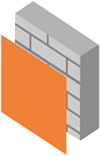Features
See allSurface preparation:
- Ensure that all substrates are clean and free from grease or oil
- A clean surface ensures proper adhesion of the primer
- Remove all loose and flaking material by scraping with a paint scraper, wire brush or by sanding
- For some metals, flame cleaning or grit blasting may be necessary
Application Procedure:
- When applying red oxide primer, use a brush or a short pile roller Thinning is not required if applying by brush or roller
- For airless sprayer thin primer 10% to 15% by volume with Berger Reducer #2
- Begin thinning with as little solvent and add more as needed until the right consistency is achieved
- Spray red oxide primer onto the surface with a minimum working pressure of 2000 psi
- Apply 1 coat to provide an adequate base coat to your metal
- Touch dry 15 minutes. To handle 1 hour and recoat time 4 hours
Tips: Berger recommends applying two (2) coats in conditions of high humidity and severe exposure.
Tools you will need
Available Packs

1 Coat
6 m2/ ltr**
Coverage
On well-prepared surfaces, as per the painting system recommended. Please refer to the Product Data Sheet for surface preparation and method of application.
** Actual coverage may vary from the quoted coverage due to factors such as method and condition of application, surface roughness, and porosity.
Solve Potential Paint Problems
Reddish-brown stains on the paint surface are called nail head rusting and are usually a sign that the surrounding wood may be rotting.
What are the possible causes?
- Non-galvanized iron nails exposed to moisture
- Nails not properly countersunk
- Nail heads not caulked with siliconized caulk before painting
- Frequent exposure to damp wood
What is the solution?
- Completely remove the nail and replace with a new nail
- Wire brush each nail head until bare shiny metal
- Clean and spot priming with appropriate Berger primer
- Caulk nail heads with paintable Berger acrylic caulk
- Topcoat with premium Berger acrylic or oil paint
We recommend you use these painting systems in order of base coat, first coat, and second coat:
Patchiness generally occurs when insufficient paint has been applied or when paint is applied unevenly, resulting in a variation of the film build leading to patches.
What are the possible causes?
- Inconsistent distribution of paint on the surface
- Incorrect or low quality paint brush or roller
- Failure to apply a primer over joint compound
- Applying paint over joint compound not fully dried
- The top coat is applied over spot-puttied surfaces
- Variations in surface gloss can cause paint to appear patchy
What is the solution?
- Increase the amount of paint on the brush or roller to allow better distribution
- Apply the paint in a grid fashion to ensure an even finish
- Allow puttied wall to dry evenly before priming
- By applying one coat of appropriate premium Berger Primer
- Apply two coats of premium Berger acrylic topcoat
- Refer to Berger Technical Support for primer options
We recommend you use these painting systems in order of base coat, first coat, and second coat:
Poor hiding occurs when paint fails to obscure or hide the surface to which it is applied.
What are the possible causes?
- Using low-quality paint with little hiding power
- Spreading paint too thinly or unevenly
- Over-thinning paint beyond the recommended amount
- Failure to prime the surface before top-coating
- Painting a porous or absorbent surface
- Using incorrect or poor quality tools
- Inadequately mixed paint
What is the solution?
- Prime first, if moving from a significantly darker to a light colour
- When painting in a dark colour, tint primer in a similar tone to the topcoat shade
- Use premium quality paint for better hiding and flow
- Use quality and correct tools for the job
- Follow manufacturer's recommendation for thinning
We recommend you use these painting systems in order of base coat, first coat, and second coat:
we also recommend
-
Get Inspiration
-
Make Your Plan

Let us design a project plan to suit your needs.
-
Colour Tools














-can_0715.png?width=82&height=102&mode=crop)

